#hapa zome
Text
youtube
How to flower pound with fresh flowers, tataki zome, hapa zome.
BillyNou shop on https://www.billynou.com/
How to flower pound with flowers
How to natural dye with tataki zome?
how to create a hapa zome print?
Hammered flowers art, flower pounding DIY
How to use flowers to dye fabric.
BillyNou is about the wonderful process of natural dyeing I do for my brand, life, motherhood and the trails and errors of making and crafting.
I’d like to inspire others to become more conscientious, to find a connection with nature and benefit from this immense and totally accessible energy.
I love what I do and try to live what I love. I offer you a window into my personal journey with the hope of being some benefit to you in one way or another.
FOLLOW US: @billynouapparel @billynoustore
https://www.instagram.com/billynouapp...
FACEBOOK: billynouapparel
WEBSITE: https://www.billynou.com/
#BillyNou#solarpunk#flower pounding#flower printing#flower print#eco print#eco printing#flowers#tataki zome#hapa zome#diy#how to#how to eco print#do it yourself#how to flower pound#Youtube
12 notes
·
View notes
Text
instagram
My semester project done during my Erasmus exchange at HDK-Valand in Göteborg, Sweden 😊
Sewn pieces of thrifted fabric with organic prints of leaves and flowers that I picked during my autumn/winter stay in Sweden 🇸🇪
Kryjówka (Hide), 2023, tataki zome on cotton and linen
#textiles#nature#Textile#Art#installation#Ig#Reel#Vid#Video#Natural#Tataki zome#Hapa zome#ecoprint#Ecoprinting#art#Instagram
1 note
·
View note
Text

EPFC NORTH JUNE 2023 EVENTS
Hello, Summer! Join us for some fun in the sun (and rain?) this month at Moberly Fieldhouse. All events are free and all-ages.
Workshop Online via Zoom - ART CLUB
Tuesday, June 13: 11 - 1 PM
Our 32nd Zoom installment of our international collaboration with Art Club Frome in Somerset, UK! Zoom on in for relaxed art-making on a secret theme to be announced at the start of the session. The only rule is MAKE. Free online event! Everyone welcome! More info https://www.facebook.com/ArtClubFrome/
Workshop at EPFC North Moberly Fieldhouse - PROCESS LAB Saturday, June 17: 1 - 5 PM
Drop by Moberly Fieldhouse for a relaxed afternoon of hand-processing experimentation. Got stuff to develop? BYOF! Free event! Equipment and eco/traditional chemistry provided. Everyone welcome. Moberly Fieldhouse is located in Moberly Park, 7646 Prince Albert St, Vancouver, BC V5X 3Z4
Screening at EPFC North Moberly Fieldhouse - SWEET 16 Saturday, June 17: 9 - 11 PM
We’re celebrating the return of looooooong summer evenings with a twilight screening of little gems from EPFC North’s 16mm library. Learn how to use a projector! There will be snacks. Free event! All welcome! Moberly Fieldhouse is located in Moberly Park, 7646 Prince Albert St, Vancouver, BC V5X 3Z4
Workshop at EPFC North Moberly Fieldhouse - FLOWERING: Celebrating The Garden with Phytograms and Cyanotypes
Sunday, June 18: 1 - 4 PM
Join us for an afternoon of eco-friendly art-making as we work with local plants to create beautiful images on paper and cloth. Cyanotypes are early form of photography that turn blue when you dip them in water. Phytograms, a process created by filmmaker Karel Doing, use the magic chemistry of flowers to leave ghostly silhouettes on recycled photo paper. Both processes easy to learn, fun to make, and utilize organic, non-toxic ingredients. We will have organic materials on hand for workshop participants to use but feel free to bring a few flowers or leaves from your garden to create your own unique Cyanotype and Phytogram that you will take home at the end of the workshop. Free event! Everyone welcome! Materials provided. Moberly Fieldhouse is located in Moberly Park, 7646 Prince Albert St, Vancouver, BC V5X 3Z4.
Workshop at EPFC North Moberly Fieldhouse - KITES IN FLIGHT: MAKE + FLY
Saturday, June 24: 11 AM – 2 PM
Let’s fly kites! Bring your own or make one with us out of recycled materials. Supplies provided. Free event! Everyone welcome. Moberly Fieldhouse is located in Moberly Park, 7646 Prince Albert St, Vancouver, BC V5X 3Z4.
Workshop at EPFC North Moberly Fieldhouse - FIRST IMPRESSIONS: HAPA-ZOME Sunday, June 25: 1 PM – 4 PM
Hapa-Zome is a Japanese term meaning ‘leaf-dye.’ local treasures. Working with leaves and flowers from the Moberly Fieldhouse Cinema Garden, we’ll make imprints on cloth that celebrate the vibrant colours of summer. Free, all-ages event. Materials provided. Moberly Fieldhouse is located in Moberly Park, 7646 Prince Albert St, Vancouver, BC V5X 3Z4.
Workshop Online via Zoom - HAIKU YOU
Wednesday, June 28: 4 - 5 PM
“A Japanese verse form most often composed, in English versions, of three unrhymed lines of five, seven, and five syllables. A haiku often features an image, or a pair of images, meant to depict the essence of a specific moment in time.”—Poetry Foundation In this workshop for poets and filmmakers, we’ll use the natural wonders of the season as our inspiration to write and share haikus and then turn them into experimental short films. Free event! To sign up and receive the Zoom link send an email with HAIKU in the subject line to [email protected]
1 note
·
View note
Photo

Galeri Soyut, 21 Ekim – 9 Kasım 2022 tarihleri arasında, Yıldız / C Salonunda, Duygu İrem Can’ın “Yazı Tura” isimli kişisel resim sergisine ev sahipliği yapıyor. Yazı ve Tura… Aynı hayat gibi, beklenmedik ve tesadüfi… Ekolojik baskı uygulamalarından Hapa-Zome* ve Pas Baskı** tekniklerinin tekrarlanamaz ‘teklik’leri ve beklenmedik sonuçları, bana biraz da yazı turayı anımsattı. “Haydi gülümseyin, çekiyorum” derken, çiçekler solmadan önce kumaştaki fotoğraf olacaklarını nereden bileceklerdi. Ve pas, ilk duyulduğunda ‘kir’ken aslında o da poz verdi bir tabloya. Çiçeklerin ve pasın kumaş üzerindeki benzersiz dönüşümleri ve bir anlıkken sonsuz olmaları. Pas ve çiçek baskıları… İşte dedim ya, biraz hayat gibi. Gülümseyin, çekiyorum… * Bir Japon tekniği olan Hapa-Zome; yaprakların çekiçle dövülerek kumaşa renklerinin ve şekillerinin geçmesidir. **Pas baskı tekniğinde; paslı ya da paslanabilir doğal malzemeler ile, tüm tekstil yüzeylerinde desen oluşturulabilmektedir. Duygu İrem CAN 1983’te Ankara’da doğdu. 2006 yılında Anadolu Üniversitesi, Moda Tasarımı Bölümü’nden mezun oldu. 2006 yılında Erasmus programıyla Litvanya Kaunas College’da moda tasarımı alanında eğitim aldı. 2012’de moda tasarımında koleksiyon hazırlama konusuna odaklanan teziyle yüksek lisansını, 2016 yılında Eko Boyama-Baskı üzerine yaptığı çalışmalarla Sanatta Yeterliliğini tamamladı. Eskişehir Teknik Üniversitesi, Tekstil ve Moda Tasarımı bölümünde Dr. Öğretim Üyesi olarak görevini sürdüren Can, akademik ve sanatsal çalışmalarını sürdürmektedir. Gallery Soyut hosts Duygu İrem Can’s personal painting exhibition titled “Heads or Tails” between 21 October – 9 November 2022 at Yıldız / C Hall. #duyguiremcan #galerisoyut#galerisoyutçankaya#galerisoyutyıldız#ankara#artgallery#artankara#sanatgalerisi#sergi#sanat#soyutgaleri#exhibition#kültürsanat#turkishart#turkishpainting#artistanbul#soyut#sanatci#sanatçı#resim (Galeri Soyut) https://www.instagram.com/p/Cj2midUs9uO/?igshid=NGJjMDIxMWI=
#duyguiremcan#galerisoyut#galerisoyutçankaya#galerisoyutyıldız#ankara#artgallery#artankara#sanatgalerisi#sergi#sanat#soyutgaleri#exhibition#kültürsanat#turkishart#turkishpainting#artistanbul#soyut#sanatci#sanatçı#resim
0 notes
Text
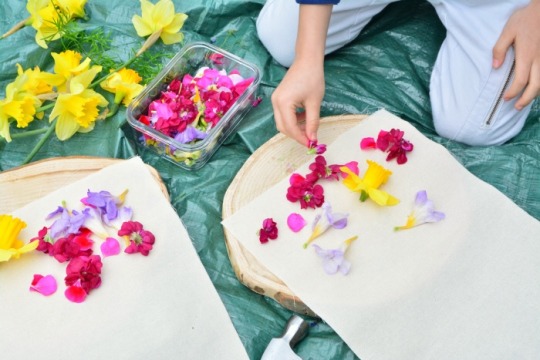

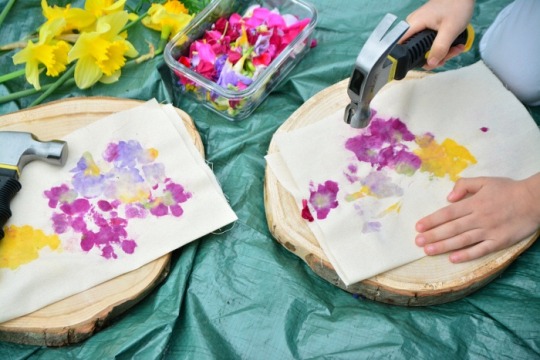

Hapa Zome is a term coined by textile artist India flint which loosely translates to ‘leaf dye’. It refers to the process of transferring the natural pigments from leaves or flowers onto paper or cloth to create a botanical print.
#hapa zome#art#nature textile#nature art#leaf dye#flowers#flower art#nature#upload#natural dye#pigments#organic pigments#flower#art project#leaves#naturecore#nature inspired#cloth#fabric#fabric art#flower aesthetic#spring aesthetic#spring#garden#colors#india flint#botanical#flora#flora fun
19 notes
·
View notes
Text
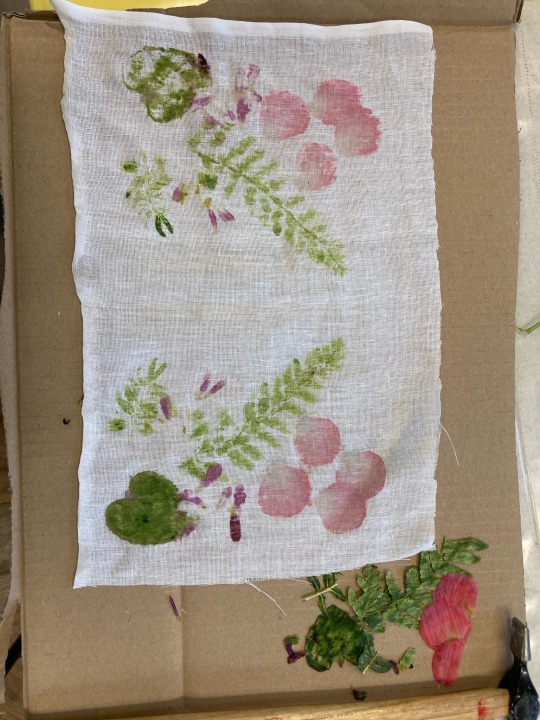
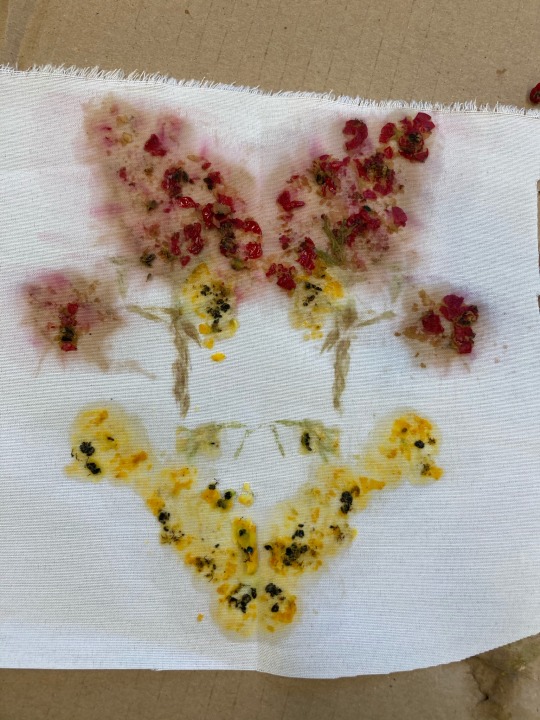

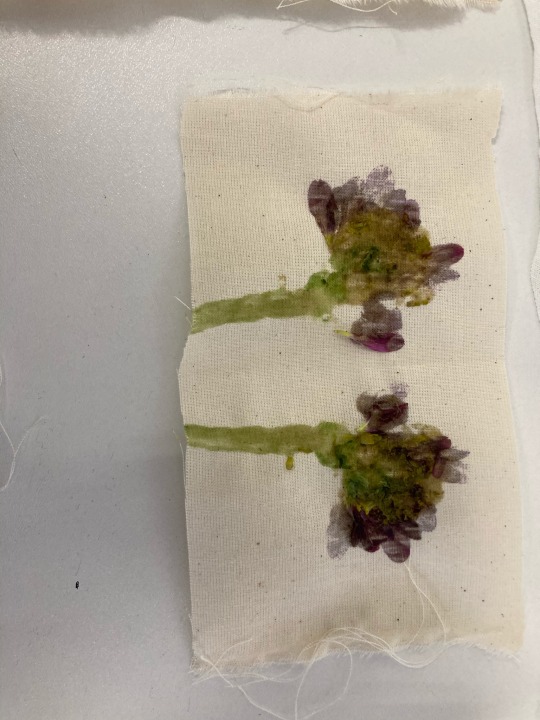

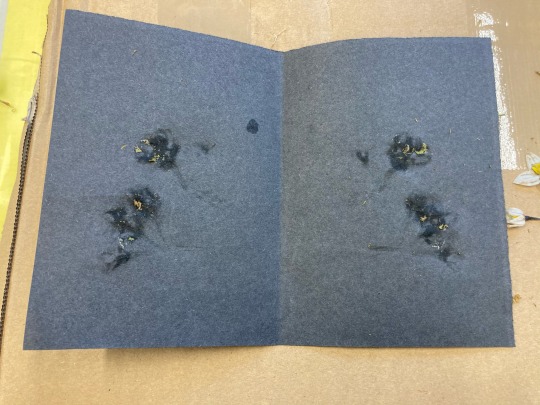
Hapa Zome ., bashing leaves and petals with a hammer. Creating some lovely delicate results .. will definitely be exploring this more !
2 notes
·
View notes
Photo

'warmth' wall; wovens + much rust-dyed and painted yardage (silks, linen and Romanian hemp twill) dyed with lac, cochineal, black walnuts and ph modifiers + hapa-zome dyed turkey tail mushroom (at Parsons School of Design) https://www.instagram.com/p/B4zw09FFIpQ/?igshid=kc88n32qf2re
1 note
·
View note
Text
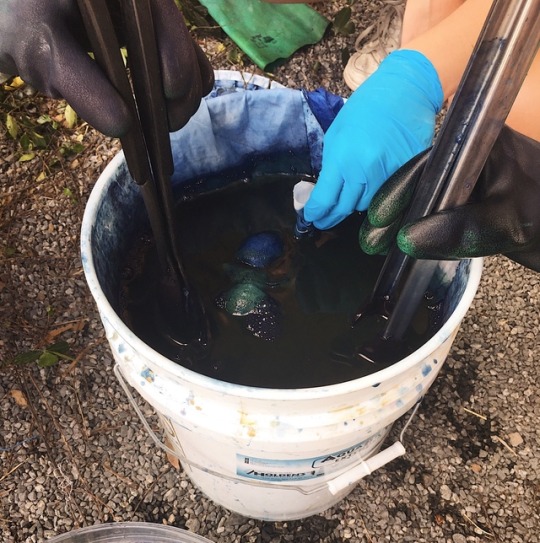
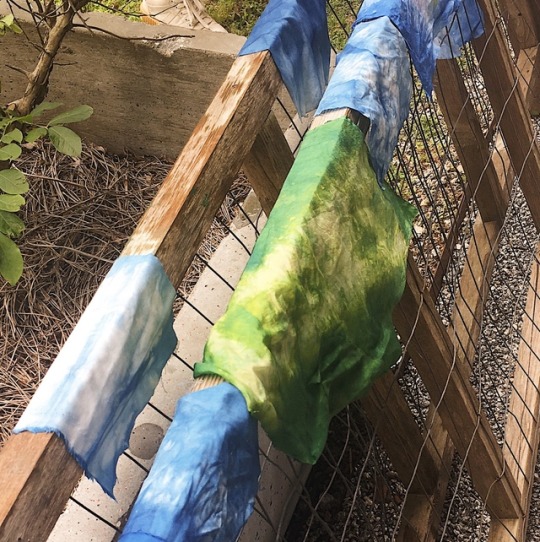
Went to the natural dyeing workshop this afternoon and got to experiment with dyeing with indigo and “hapa-zome” aka plant dyeing via pounding lol 🌿
It was a lot of fun and I’m really glad I went! I can put the ones I made into my creative sketchbook for my textiles class which is great because a) it saves me from having to do this by meself, and b) adds like, 6 pieces to it (need 30-50 in the end omg)
Happy weekend y’all ✌🏻
2 notes
·
View notes
Photo

Hapa-Zome
Leaf dying using a hammer.
This wasn't as quite successful as other forms of plant dying. Each plant according to its water content reacted differently, leading to a very inconsistent look. I also found the process unnecessary and if I wanted to print flowers on fabrics there are better ways such as eco printing.
0 notes
Text
youtube
HOW TO NATURAL DYE WITH TATAKI ZOME | HAPA ZOME | FLOWER AND LEAF POUNDING
Tataki zome is an ancient Japanese natural dye technique that transfers color directly from a flower or leaf to a piece of fabric.
It is simple, fun and magical and loved by children and adults.
In this tutorial, you will learn how to use a hammer to transfer color from leaves and flowers onto fabric.
#The Barefoot Dyer#solarpunk#Tataki zome#flower pounding#leaf pounding#diy#do it yourself#eco print#natural print#print#Youtube#flower print#flower printing
5 notes
·
View notes
Text
Draping my Hapa zone fabric
After creating the hapa zome print on the fabric, I experimented with draping and pinning the fabric on a mannequin to create possible ways in which you could create a garment from it. Draping is a great way to generate loads of quick ideas about how a garment could be worn. We got a range of more fitted garments as well as looser fitting ones, experimented with pleating,tying the fabric, including other fabrics with our hapa zome one etc. I think that next time I would experiment more with gathering and bunching the fabric, to create some more unusual silhouettes. I think that it was really successful when some big bold and bright flowers were on the front of the garment as they created a statement and makes it look like the print was placed strategically.
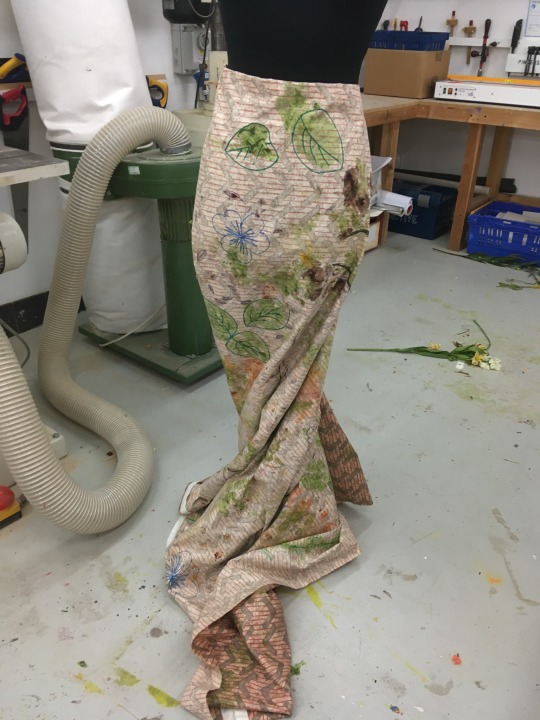
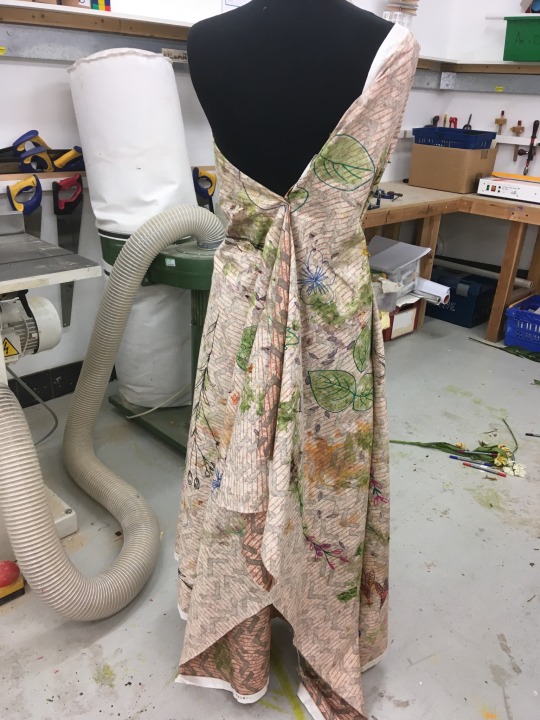







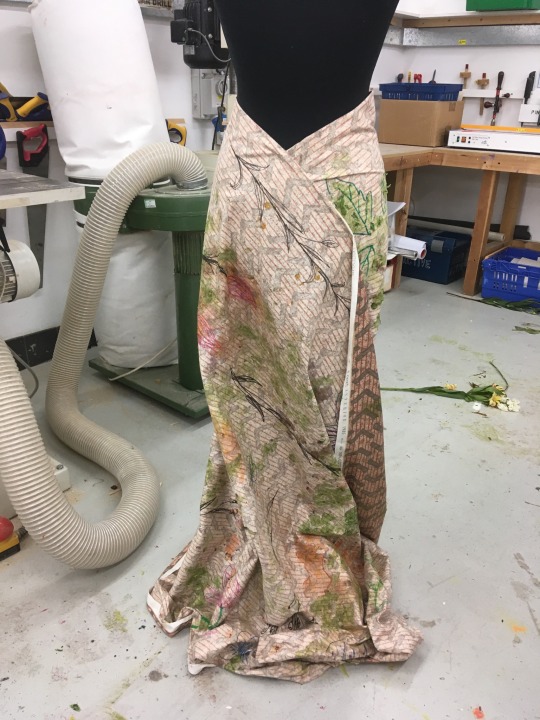
0 notes
Text
Final Evaluation
I explored a range of different techniques and learnt many new techniques including Hapa Zome, eco-dying, fabric dying etc. The most effective technique that I explored was lino print; this is something that I am really interested in as you can get a range of textured designs. Print was my main technique that I used as I printed wallpapers and cushion covers. Throughout the project I look at a wide range of artists including, Vivien prideaux, Nancy Wolff and Hilary Waters. They influenced my work and gave me ideas for different materials and techniques to use. I also learnt how to edit magazine covers using photoshop which was useful when editing my final photoshoot images and creating a final interior magazine cover. The artists that inspired me for editing covers were Hattie Stewart and Ana Strumf. I loved their bold, intense, colourful and patterned designs. The techniques I explored throughout the project met the purpose of the proposal as I used a range of natural materials, used natural materials to dye fabric, print with and sew into. I also gathered all my inspiration from nature, specifically leaves and trees.
I didn't come across many problems throughout the project, however when making my final outcomes I made a large cushion. I made the back pieces slightly too small so they did not overlap that much at the back. To overcome this problem I attached a button and elastic to the back so it could be fastened up to close the back up. On one of my final wallpaper lengths one of the leaf prints went slightly wrong however when you look at the length all together you don't notice. I couldn't find a large lampshade in a charity shop, so I have created a smaller weaved lamp shade which was still really effective and looked really nice on the wooden side table. When photographing my final pieces I came across a few problems, my wallpapers wouldn't stay on the wall long enough for me to photograph them and because the wall is curved at the bottom I couldn't place the furniture where I wanted them. I then ran out of time because the photo studio was booked up so I had to create a backdrop in the workshop to photograph my final piece which worked really well and I was happy with the results. The point of my work is to raise awareness for deforestation, to make people fall in love with leafy patterns and want to include them in their houses more often. My fmp could be further developed by making a small rug to be on the floor in front of the chair as this would create a sense of warmth to the interior setting as well as bring in some more soft furnishings.
My final outcomes have turned out really well and all are finished to a high standard. I have created two wallpaper lengths of different designs, two cushion covers, a small lampshade, and my best wall hangings and fabric samples have also been displayed alongside my interiors. I have displayed all of these interiors in a professional interior set up and photographed them as you would see them in an interior magazine. I wanted to bring the outside in and I have definitely achieved that with the leafy patterns throughout my interiors and weaving the natural materials through my weaved pieces. I wanted to raise awareness of deforestation and make people realize how precious trees are, when they look at my work and make them want to help stop the global deforestation issue.
I planned my time very well, I managed to get a lot of work done very quickly as I work at a fast pace, so my schedule changed as Ii finished my final pieces early and then only had to finish off write up work and make sure my sample sketchbook was presented nicely. I also made sure that I had the right materials for each day and which tasks and interiors I was going to make. When I got feedback and targets I would work towards them and achieve them each time to make my work stronger. This helped me to develop my work throughout the project to make sure I had enough research, sampling etc. being critical of your own work as well as getting critical feedback allows you to refine your ideas to get a successful and high quality outcome. This has impacted on my work because when talking with tutors it inspires more ideas and further sampling that I could explore, which then I might find a sample I think is more effective than a previous one I have created. I think I challenged myself relatively well in previous projects. I have only made one outcome, however with this project I created a few final outcome interiors to really showcase the techniques and skills that I have learnt. I have learnt that I can push myself and make a lot of outcomes quickly which means I can push my skills and techniques to create more complicated and intricate pieces which I will do in future projects.
0 notes
Text



Eco Printing: Process
Using the Hapa Zome (flower pounding) technique.
0 notes
Photo

"TEST OF TIME No. 4" MATERIALS: Queen Anne's lace, silver suede, agapanthus, golden flakes. On canvas. METHOD: Prepared and arranged by hand, hapa zome applied. Botanical collage. Wall art. SIZE: 64cm X 24cm X 10cm COMPLETION DATE: 8th March 2021 by @shokai.ikebana DM for interest. Available for purchase and fundraising purposes. All profits will go towards registered charity organisations or a good cause. Test of Time is a series of work examining the parallel narratives and experiences in mental resilience and the life cycles of materials theough ikebana aesthetics. By processing and repurposing wilting plant materials, this piece is another attempt to emanate my view on 'reframing' and repurposing vulnerabilities. Vulnerability is the birthplace of creativity, connection, and resilience; and as you wilt and fade, I'm here to capture your presence, essence, and beauty. It's time to take a perspective, and break down the stigma. Choose hard conversations over comfort. #japaneseaesthetic #ikebanamelbourne #ikebana #botanicalart #botanicalcollage #stkildaart #supportlocal #hapazome #supportlocalmelbourne #testoftime #melbourneflorist #melbourneartist #mentalhealthawareness #beyondblueanxiety #reusereducerecycle #craftmelbourne #resilience #queenanneslace #driedflowerarrangement #brenebrown #supportlocalartists #authenticity #wallart #wallhanging #melbourne #wabisabi #japandi #reframingvulnerability #artistruninitiative #mindfulness (at Melbourne, Victoria, Australia) https://www.instagram.com/p/CMJlQTKDwOI/?igshid=1v0g728vkosmd
#japaneseaesthetic#ikebanamelbourne#ikebana#botanicalart#botanicalcollage#stkildaart#supportlocal#hapazome#supportlocalmelbourne#testoftime#melbourneflorist#melbourneartist#mentalhealthawareness#beyondblueanxiety#reusereducerecycle#craftmelbourne#resilience#queenanneslace#driedflowerarrangement#brenebrown#supportlocalartists#authenticity#wallart#wallhanging#melbourne#wabisabi#japandi#reframingvulnerability#artistruninitiative#mindfulness
0 notes
Text
Weekly Reflection: 05.03.21:
This week I have been experimenting with different sub-trends following on from last week. This week I have been experimenting with creating imagery that portrays the sub-trend of ‘Duvet Day’, I did this through using different puffer jackets creating an oversized layered effect to the images. I also experimented with the trend of ‘the new standard’. I styled this trend on my friend. We then went on a walk to take these photographs, adapting to the restrictions of the pandemic, thinking of alternative ways to capture fashion communication based outcomes safely. I also captured the trend of ‘speakeasy style’. This trend focuses on silk clothing so I styled a silk dress on my model and took photos at different locations and backgrounds on our walk, experimenting with different poses and angles throughout. This week I set myself a target to complete three different photoshoots of the sub-trends/ styles as well as a creative hand-based outcome. This week the research that I have done gathering inspiration for my different photoshoots from stylists, brands and artists has helped me with my photoshoots and hand-based outcomes. I researched different smaller stylists and bloggers for inspiration on outfits and locations to take photographs.
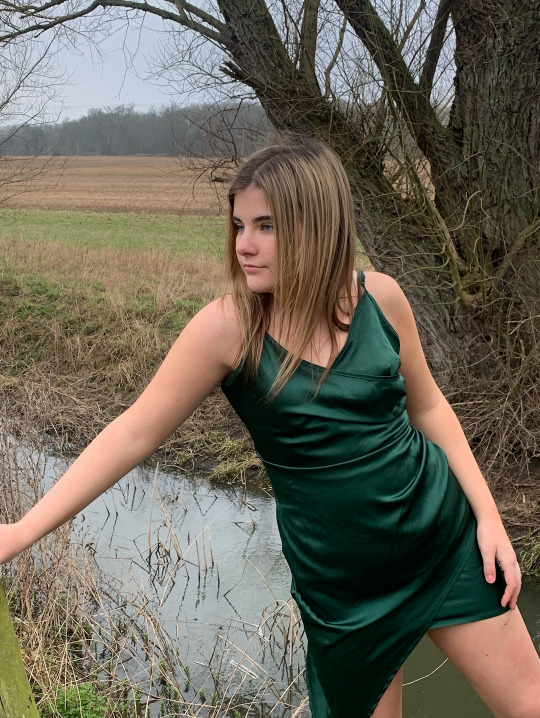
Speakeasy Style Photograph

The New Standard Photograph

Duvet Day Edit
This week I have experimented with the practical technique of Hapa Zome using flowers to press the natural ink onto cotton. I used the materials of a hammer, flowers and cotton for this technique. This was a new technique to me, however I enjoyed experimenting with this. I then added some stitching onto the print. Afterwards, I thought about the different way in which this item could be creatively styled in a fashion communication based way. I used stitching to create this into a loose fit bardot top. This focuses on the importance of living with less and sustainability. I am focusing on this throughout my project. I will continue to experiment with upcycling and sustainability to portray my main focus for my FMP of ‘living with less’. I have pushed the practical tasks independently by doing three photoshoots as well as producing outcomes, such as edits from these, continuing to show an extensive breakdown of research, inspiration, contact sheets, edits and more. I have also focused on up-cycling an item indepently.
Next week, I am back at college. I am planning on doing a photoshoot against a white backdrop to create a minimalistic feel to the photoshoot. I will also experiment with typography throughout my edits. I also am planning on experimenting with the use of fabrics, and up-cycling spare fabrics to become something different. I will use different spare materials and layer these, I may incorporate some stitching onto the fabrics. Then I will think about how these fabrics and materials can be formed to create something new through up-cycling. I will experiment with this next week and in the up-coming weeks.
0 notes
Text
Live practical session - Hapa Zome
today I discovered Hapa Zome, Hapa Zome is an ancient Japanese art form, based on leaf printing. Tamara Jewell shows us how to create beautiful artwork, inspired by symmetry in nature.
Hapa Zome is a method of natural print where print is created by hitting the pigment from the flowers directly onto cloth. The technique is semi permanent and allows you to make beautiful ornate designs. By folding the cloth in half with the leaf or petal inside you get a mirror image. Once the petal is under the cloth then it is a matter of gently pounding it with a mallet, hammer. The surface underneath will come through. This is a ‘mono’ print meaning it’s a one of and can be a bit hit and miss depending on the leaf/flower.
Today I used leaves from my garden a and is some cloth and using a roller pain I had I used a variety of different plants. Didn’t have many flowers all types of leaves in my garden so I tried to work with the best resources I could use. I also used a range of different coloured leaves. I found this task quite hard because it’s quite waxy lease so they didn’t work the best I still had some colour come out of the lease but I just found it didn’t really work the best. I also added some pen lines to my pieces aswell to show outline of the leaf. I then found a couple of petals and printed them on my fabric, I like the colour to this pieces. Don’t think I would like to use this process again but it’s been it really interesting working out different ways people well with sustainability in clothing. Pieces have been inspired by Julie Pishny and India Flint. 




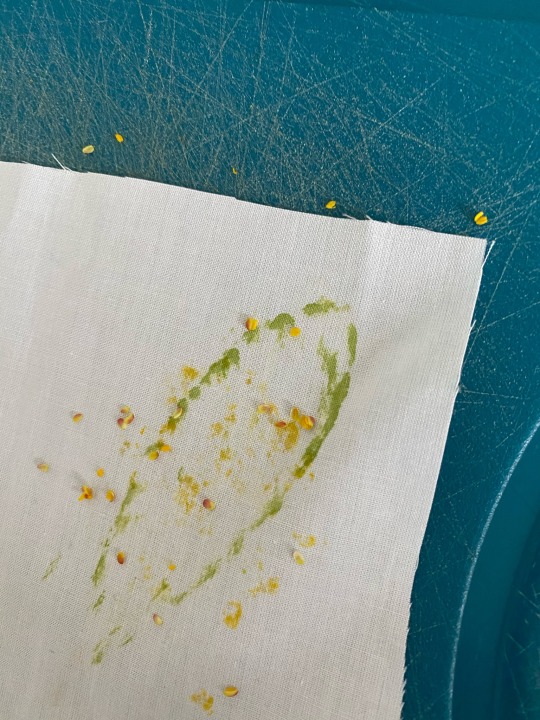





0 notes